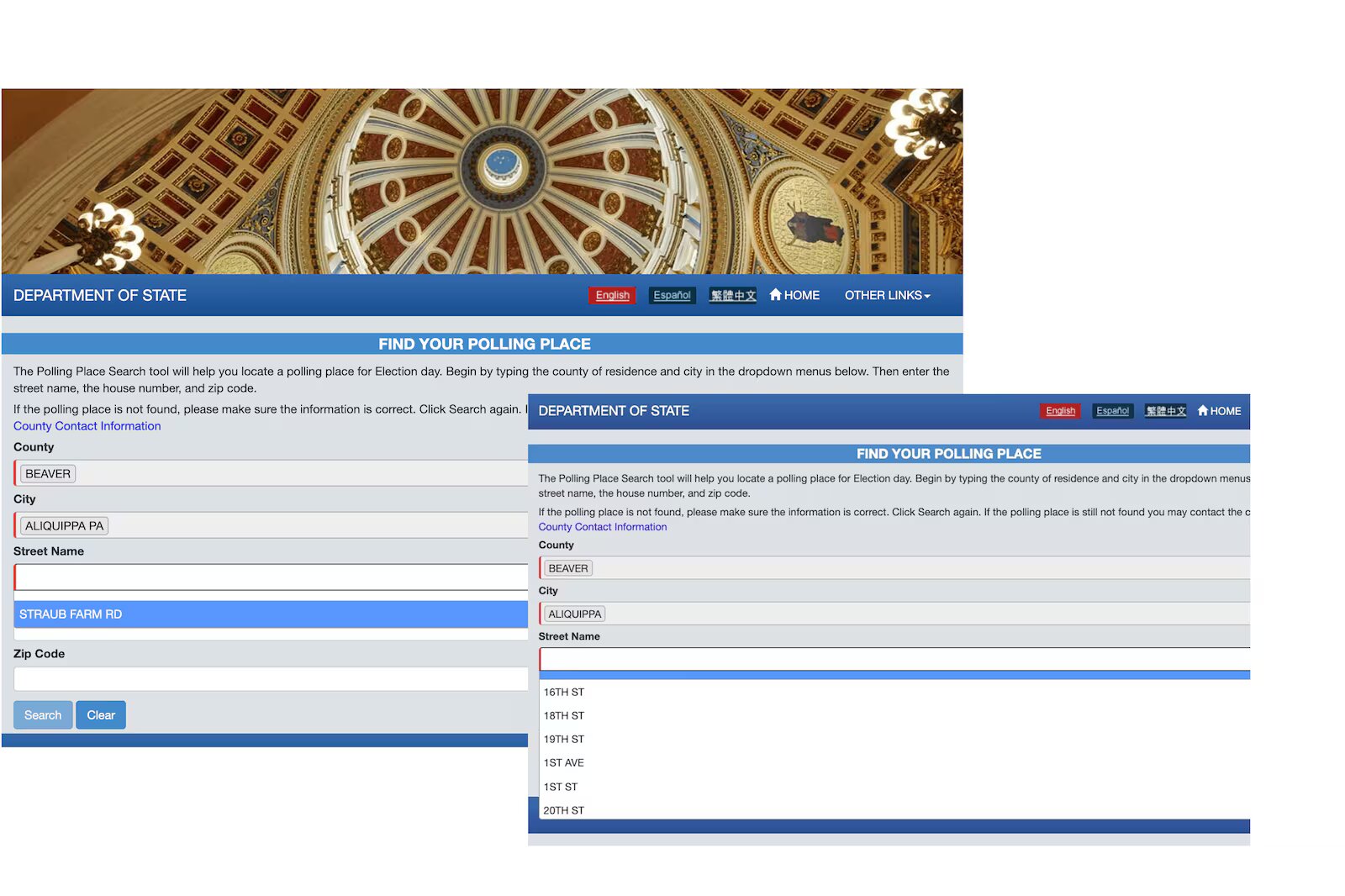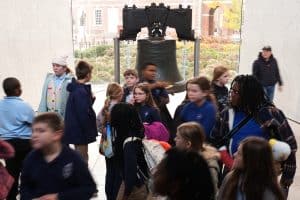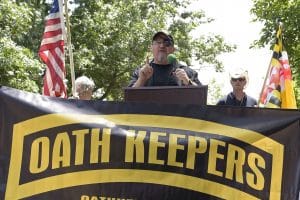An official government online tool designed to help Pennsylvanians find their polling places is riddled with misspellings and other quirks that make it difficult for some voters to use.
The errors — which users encounter when they search for their municipality and street name — affect as many as 85,000 of the state’s 8.9 million voters, a Votebeat and Spotlight PA analysis found.
The Pennsylvania Department of State said counties enter their own address information into a centralized voter management system that powers the lookup tool, and it’s their responsibility to fix the problems.
“The Department of State’s Find Your Polling Place tool reflects data that is entered and maintained in the SURE system by the 67 county boards of elections,” said Matt Heckel, press secretary for the department. “The data entered into the SURE system is not managed by the Department, but rather by the counties.”
That explanation is accurate, said one longtime county election official, but it’s not the whole story. There are many new election directors around the state who may not know about the data entry errors or how to fix them without instruction from the department, this person noted. An interaction with Allegheny County shows that even large counties can benefit from instruction from the department on fixing these issues.
Votebeat and Spotlight PA found over 100 municipality names in 40 counties that were either misspelled or had multiple variations of their spelling. The outlets then used the state’s voter roll to determine how many people lived in areas affected by the errors as of Aug. 12.
For example, in Blair County, 55 voters lived in a misspelled version of Hollidaysburg; in Mifflin County, the analysis identified 692 voters who lived in either “Mount Union” or “Mt Union.”
How the online polling place lookup tool works
To use the online tool, voters first select their county, followed by their city, street name, house number, and ZIP code. Each selection determines what options voters see in the next section’s menu. So, when a voter selects their county in the “County” dropdown menu, the “City” dropdown menu will display municipalities for only that county. The same is true for street names once a city is selected.
But because of the way the tool is constructed, if a city is misspelled or spelled two different ways, a particular street in that city may be listed under one version of the city’s name, but not the other.
READ: Voting Rights Groups in Pennsylvania Record Another Victory in Case Over Provisional Ballots
So depending on which spelling of their town name a voter chooses, they may not see their street name, and wouldn’t be able to go through the steps to find their polling place without backing out and choosing the other spelling.
For example, in Beaver County, there is an “Aliquippa” and an “Aliquippa PA” option under the “City” dropdown menu. Selecting “Aliquippa PA” shows you the option for “Straub Farm Rd” under the street dropdown, but no other streets. Selecting “Aliquippa” would show you the other street names for the municipality, but not “Straub Farm Rd.”
In Blair County, Hollidaysburg is misspelled “H0llidaysburg,” with a zero instead of an “o.”
Many other such variations show up in the tool, such as whether directional words like “East” and “North” or the word “township” in a municipality’s name are spelled out or abbreviated.
The patterns are not consistent, so some voters are affected more than others.
For the two variants on Mount Union in Mifflin County, for example, Train Trail is listed under both, but Jefferson Street is only under the “Mt” variation. So Jefferson Street voters would be affected, but Train Trail voters wouldn’t, as they could find their street under either option.
Meanwhile, dozens of other streets listed under “Mount Union” aren’t under “Mt Union.” So if voters on those streets selected the “Mt Union” variation, they wouldn’t see their street listed.
State ultimately provided guidance to Allegheny County
Juliet Zavon, an Allegheny County voter who in her free time acts as a local election administration watchdog, first noticed the errors in her county while helping a voter in McKeesport — which has three spellings in the tool — find their polling place.
When Zavon tried to look up her street, the tool returned a “no results found” message.
“I took her info and said I would check the next day and get back to her,” Zavon said. “It didn’t work the next day either, and it didn’t work the third day either, and I thought: ‘Wait a minute. There is something wrong here.’”
Zavon eventually discovered the misspellings in her county, but was never able to use the tool to find the voter’s polling place for them.
“This is just plain old sloppy practice and there needs to be standardization for this,” she said.
Zavon said she has alerted county and state officials to the issue multiple times over the past few years. Allegheny County officials recently told her they had passed the information needed to correct the errors on to the Department of State, but the department did not address the issue. A spokesperson for the county confirmed Zavon’s account. (Zavon is also a financial supporter of Votebeat. Find a list of our funders here.)
READ: How 9 Mistakenly Discarded Ballots in Luzerne County Helped Fuel Trump’s 2020 Lies About Elections
After Votebeat and Spotlight PA’s inquiry, Abigail Gardner, a spokesperson for the county, said the Department of State provided it with instructions on making the corrections, which it’s doing now.
Forrest Lehman, election director in Lycoming County, which did not have any errors, acknowledged that it is primarily counties’ responsibility to fix the errors, not least because they know their municipalities best.
He believes that turnover among election officials has left less-experienced directors unaware of these issues or unsure how to fix them. During the previous attempt to upgrade the SURE system, which ended last year when the Department of State canceled its contract with the previous vendor, Lehman said there were initial discussions about the need to clean up data before it moved over to the new system.
But the conversation never progressed. Lehman said it would be best if the department took the lead, directed counties to look for the errors, and provided instructions on how to fix them, as it did with Allegheny.
Heckel, the Department of State spokesperson, also highlighted the department’s training program for new directors and said the department is in constant contact with counties to provide advice as they use the SURE system.
But Lehman also cautioned against making any changes now to prevent the risk of introducing other unknown errors just before the election.
It’s a big data cleanup challenge, he said, “and it has to be done in the valleys between elections.”
This article was originally published by Votebeat, a nonprofit news organization covering local election administration and voting access. Sign up for their free newsletters here.
Note: Pennsylvania’s voter roll is a constantly shifting data set. The number of registered voters for a given municipality may shift from day to day. While the numbers cited in this story were accurate as of the time of the analysis, it is possible they have shifted since.
The number of affected voters could vary depending on how the data is interpreted. Voters whose addresses are listed under both the correct and incorrectly spelled version of a town name could be considered affected, as well as voters whose addresses are listed under both versions of a town with a variation such as part of the name being spelled out or abbreviated. With misspellings, Votebeat and Spotlight PA’s analysis counted only voters whose addresses were listed under the misspelled version, since these voters were more likely to select the correctly spelled version, and not find their street on that list. For towns with multiple name variations all the voters listed counted as being affected, since they would not know immediately which variation to select. Votebeat and Spotlight PA did not analyze which street names appear under which misspelling/variations, which may also impact the number of people affected.







